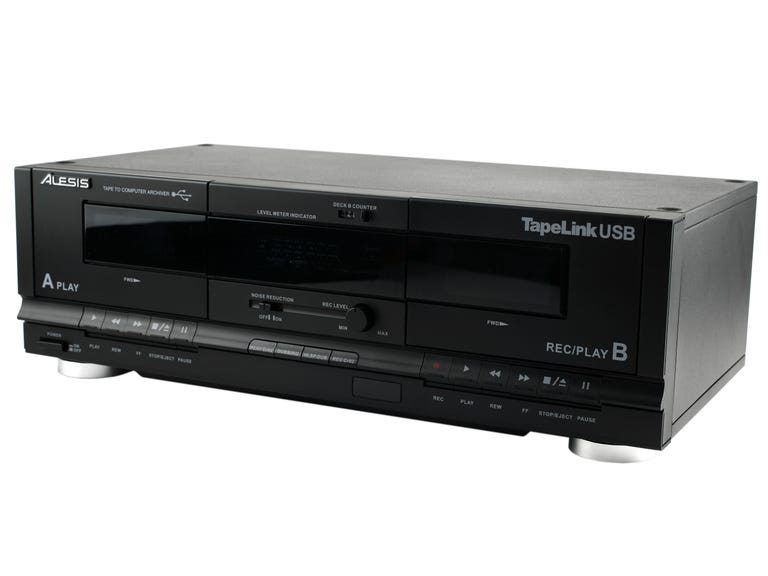 Why You Can Trust CNET
Why You Can Trust CNET Alesis TapeLink USB review: Alesis TapeLink USB
Alesis TapeLink USB
Cassette tapes are the ugly, forgotten orphans of the digital-audio age. You probably have a trunk of tapes in a closet or attic somewhere, gathering dust and serving as a time capsule for music that makes you cringe. Some of us, though, still treasure the old mix tapes, bootlegs, and band demo tapes of our youth.
The Good
The Bad
The Bottom Line
If you're itching to drag your old cassette tapes in to the digital age and load them onto your computer or MP3 player, the Alesis TapeLink USB ($299 list, $199 street) makes the transformation relatively painless. All you need is a computer and an afternoon to kill, and you can rip those old mix tapes onto your computer with a minimum of fuss.
Design
The Alesis TapeLink looks just like the cassette deck you probably owned in the '80s, except for the USB port hidden on the back. The TapeLink measures 16.5 inches wide by 8.5 inches deep by and 5.25 inches tall, and includes slots for two cassettes. Each cassette deck features buttons for play, pause, fast forward, rewind, and stop/eject, but the right-hand deck features a record button.
In the center of the TapeLink, sandwiched between the two cassette decks, is a playback-level meter, an analog counter, a switch to enable noise reduction, and a knob for adjusting the incoming recording level. Near the bottom, you'll also find buttons for controlling CrO2-type tape playback and recording, as well as internal dubbing (tape-to-tape), and high-speed dubbing.
The back of the unit isn't terribly exciting. Here you'll find RCA connections for stereo input and output, along with an attached power cable, USB output, and a small gain control knob for boosting the audio signal to your computer.
What's not included on the TapeLink, however, is any kind of autoreverse capability for playing both sides of a cassette in one pass. This seems like a huge misstep for a product meant to take the sting out of ripping cassettes to your computer. After all, if you're going to invest a few hundred dollars into a cassette deck, it should at least have all the same conveniences of your old, beat-up Walkman.
Software
Once you've gathered up all your old tapes and you have the TapeLink connected to your Mac or PC, it's time to start turning those tapes into digital files. To accomplish this, Alesis includes three pieces of software to help you capture, edit, and clean up your recordings.
The most basic piece of included software is a PC-only program called EZ Tape Converter (a more limited, Mac-only version of the software is also included). The program includes an easy-to-follow, step-by-step process for recording, labeling, and exporting your songs. It also includes a feature that detects the silences between songs and automatically splits the incoming audio into separate tracks.

If you find EZ Tape Converter too basic, Alesis also includes a recent version of the free Audacity audio editor, which allows you to make detailed crops and fades to your recording, adjust the volume, and export to a range of formats. Using Audacity takes more time than using the EZ Tape Converter software, but it affords much more control.
Finally, if you can't stand the sound of the hiss and pops of your old cassettes, a basic version of BIAS SoundSoap software is included that can work miracles on old recordings. Unfortunately, it's a standalone application, so it doesn't integrate with either of the other included programs and requires a time-consuming extra step.
Final thoughts
The Alesis TapeLink USB works as advertised, but you'd do just as well investing in a modest sound card, downloading a program like Roxio RecordNow Music Lab (PC) or CD Spin Doctor (Mac), and connecting up a thrift-store cassette deck. In fact, an old cassette deck may save you more time, considering that the TapeLink lacks important conveniences, such as autoreverse.
That said, if you're looking for a one-stop solution for digitizing those old cassettes, and you've no patience for managing audio cards and vintage tape decks, the Alesis TapeLink USB will get the job done.


